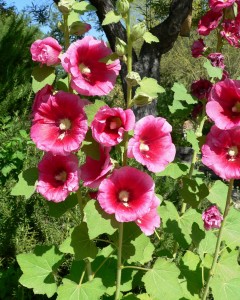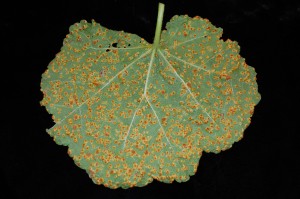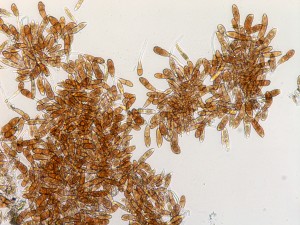Happy Labor Day, which was yesterday of course, but I had the day off and hope you did too, and were out in your garden enjoying the diseased and insect riddled plants.
Hollyhocks were once popular flowering plants. They are in the genus Alcea (syn: Altheae), which includes about 60 species in the mallow family, Malvaceae. There are many cultivars of hollyhock including some with flowers so dark they are almost black. Breeds with red flowers attract hummingbirds, butterflies, and other pollinators. They are rather large, stately plants with big flowers and cool seedpods (schizocarps). Seeds, by the way, are easy to collect. Some might say this plant is a little “old school” for modern tastes and problematic for others, but in my view, hollyhock makes an excellent addition to any cottage garden.
The thing that makes growing hollyhock problematic for most folks, but most awesome for me, is that they get hammered with rust. The fungus, Puccinia malvacearum, causes hollyhock rust. This rust has one spore stage (microcyclic) and does not have an alternate host (autoecious). It overwinters on plant debris and moves by wind and water to new plants as they emerge in the spring. Once the plants are infected, the rust never sleeps so the disease stays active and continues to progress on the plant until most of the leaves are killed by early fall.
Symptoms of hollyhock rust begin as small yellow spots on the upper leaf surface. Turn infected leaves over to find rust colored fungal fruiting bodies called telia. Large numbers of teliospores are formed in these fruits, which are easily moved about in splashing rain or irrigation.
Vigorous sanitation is the best policy with hollyhock rust. Carefully monitor and remove infected leaves as they appear. Cull out badly damaged plants and be sure to remove all plant parts at the end of the season. Remember, the fungus overwinters on dead plants, so unless your compost pile is actually cooking (mine is just a pile, no composting involved), then I might send (although the stems make decent kindling) the diseased plant material to the landfill. Avoid wet foliage, space plants properly, provide good air movement and sunlight, and use trickle verses overhead irrigation and you might slow the disease.
Fungicides are labeled, but why bother? Sit back and enjoy the show – some birds and bees, and the rust that never sleeps.






